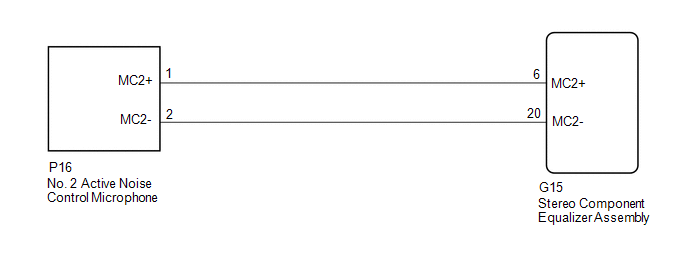Lexus ES: Front Right Microphone Circuit Component Internal Failure (B1AA696,B1AA71C)
DESCRIPTION
These DTCs are stored when a malfunction occurs in the No. 2 active noise control microphone system.
| DTC No. | Detection Item | DTC Detection Condition | Trouble Area |
|---|---|---|---|
| B1AA696 | Front Right Microphone Circuit Component Internal Failure | Stereo component equalizer assembly detects malfunction in No. 2 active noise control microphone for 4 seconds or more continuously when engine speed is 1200 rpm or more* |
|
| B1AA71C | Front Right Microphone Circuit Circuit Voltage Out of Range | Stereo component equalizer assembly detects No. 2 active noise control microphone connection malfunction for 4 seconds or more continuously* |
|
HINT:
*: Malfunction monitoring is not performed under the following conditions, in order to prevent erroneous detection.
- After engine switch is turned on (ACC) for 3 seconds or more.
- After the battery voltage returns to normal for 3 seconds.
- Before 3 seconds have elapsed after battery voltage has returned to normal.
WIRING DIAGRAM

PROCEDURE
| 1. | CLEAR DTC |
(a) Clear the DTCs.
Body Electrical > Active Noise Control > Clear DTCs
|
| 2. | CHECK FOR DTC |
(a) Check for DTCs with all of the detection conditions met.
Body Electrical > Active Noise Control > Trouble CodesOK:
No DTCs are output.
| OK |  | USE SIMULATION METHOD TO CHECK |
|
| 3. | CHECK HARNESS AND CONNECTOR (STEREO COMPONENT EQUALIZER ASSEMBLY - NO. 2 ACTIVE NOISE CONTROL MICROPHONE) |
(a) Disconnect the G15 stereo component equalizer assembly connector.
(b) Disconnect the P16 No. 2 active noise control microphone connector.
(c) Measure the resistance according to the value(s) in the table below.
Standard Resistance:
| Tester Connection | Condition | Specified Condition |
|---|---|---|
| G15-6 (MC2+) - P16-1 (MC2+) | Always | Below 1 Ω |
| G15-20 (MC2-) - P16-2 (MC2-) | Always | Below 1 Ω |
| G15-6 (MC2+) or P16-1 (MC2+) - Body ground | Always | 10 kΩ or higher |
| G15-20 (MC2-) or P16-2 (MC2-) - Body ground | Always | 10 kΩ or higher |
| NG |  | REPAIR OR REPLACE HARNESS OR CONNECTOR |
|
| 4. | REPLACE NO. 2 ACTIVE NOISE CONTROL MICROPHONE |
(a) Replace the No. 2 active noise control microphone with a new or known good one.
Click here .gif)
.gif)
|
| 5. | CLEAR DTC |
(a) Clear the DTCs.
Body Electrical > Active Noise Control > Clear DTCs
|
| 6. | CHECK FOR DTC |
(a) Check for DTCs with all of the detection conditions met.
Body Electrical > Active Noise Control > Trouble CodesOK:
No DTCs are output.
| OK |  | END (NO. 2 ACTIVE NOISE CONTROL MICROPHONE IS DEFECTIVE) |
| NG |  | REPLACE STEREO COMPONENT EQUALIZER ASSEMBLY |


